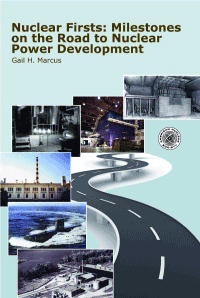New nuclear history book is available
Gail Marcus's new book, Nuclear Firsts: Milestones on the Road to Nuclear Power Development, is now available by visiting the online ANS Store.
 Nuclear Firsts traces the technical evolution of nuclear power development in the United States and around the world. In all, about 80 facilities and events in more than 10 countries are profiled. Developments in reactor technologies of all types are covered, as well as developments in reprocessing, enrichment, waste disposal, and some nonelectrical applications of reactors, such as radioisotope production, district heating, desalination, and neutron beam therapy. The book also covers the first government and private organizations that developed around the nuclear industry.
Nuclear Firsts traces the technical evolution of nuclear power development in the United States and around the world. In all, about 80 facilities and events in more than 10 countries are profiled. Developments in reactor technologies of all types are covered, as well as developments in reprocessing, enrichment, waste disposal, and some nonelectrical applications of reactors, such as radioisotope production, district heating, desalination, and neutron beam therapy. The book also covers the first government and private organizations that developed around the nuclear industry.
Well-known facilities and events, such as the first demonstration of controlled fusion and the first uses of reactors to produce electricity, and lesser known ones, such as early reactors in Antarctica and at the Panama Canal, are covered. Although many facilities are mentioned in the text or in tables, only "first of a kind" are discussed in detail. Tables are included to identify other firsts, such as the first reactor in a state or country, that may be of interest to the individual reader.
The book's six chapters cover:
- The scientific developments leading to the first demonstration of controlled fission.
- The developments leading to the the first demonstration of the production of usable amounts of electricity.
- The rapid evolution to an operating commercial nuclear plant built for peaceful purposes only.
- The growth of nuclear reactor applications.
- The maturation of the nuclear industry.
- Where the firsts have led and what lies ahead.
Nuclear Firsts is written for a broad audience. Nuclear professionals will find it useful as an authoritative reference, while science teachers and students can use it as a general educational tool. The book also will appeal to organizations associated with the various firsts and to residents near the sites of the firsts because it provides information about the historical importance of locations in their own neighborhoods. The international community will also find the book of interest because it is not limited to U.S. firsts.
Gail Marcus is a consultant for nuclear technology and policy. Previously, she served as deputy director general for the OECD Nuclear Energy Agency, principal deputy director of the Department of Energy's Office of Nuclear Energy, and in various senior-level positions at the Nuclear Regulatory Commission. She is also a past president of ANS (2001-2002).


